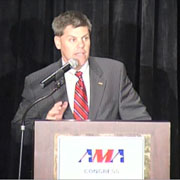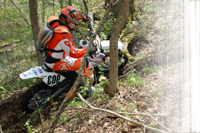N41st ANNUAL AMA CONGRESS
Updates from the 41st annual assembly
AMA Congress gathered October 9-11 to consider numerous issues affecting amateur motorcycle competition and recreational riding in the United States Rule changes passed by AMA Congress include the regulation of motorcycle sound levels at competitive events. The AMA Congress passed a 94 dB/A standard for all amateur and Pro-Am motocross and off-road competition, effective in 2011. The new level mirrors both the 2009 standard for professional and Supercross racing in the United States, as well as the level mandated by the FIM (Federation Internationale de Motocyclisme), which governs international motorcycle competition. Currently, sound limits for amateur motorcycle competition are 99 dB/A for closed-course competition and 96 dB/A for cross-country racing. "Few issues contribute more to misunderstanding and prejudice against the motorcycling community than excessively loud motorcycles, and this measure addresses the issue head-on." said AMA President and CEO Rob Dingman. "This standard is already in place for professional and international competition, making this one of the most cost effective and easy to implement solutions to the sound problem. That said, AMA Congress understands that amateur competitors may need more time to adopt this new standard and wisely establish a reasonable deadline for compliance." 
View AMA President and CEO Rob Dingman's
presentation to AMA Congress
Click HERE to download supporting documents from the presentation Other rule amendments for off-road
C. Sound Requirements
- The maximum sound limit is set at:
For pre-race inspection Max 96 dB/A for motorcycles with a 2 stroke engine Max 94 dB/A for motorcycles with a 4 stroke engine For post race inspection Max 98 dB/A for motorcycles with a 2 stroke engine Max 96 dB/A for motorcycles with a 4 stroke engine
- The test will be conducted at a fixed RPM TBD
- Chapter 2 Section C Paragraph 13 Page 13
Effective 2011 competition season
- The sound level meter must be to international standard IEC 651 or American National Standards Institute (ANSI) S1.4-1983 specifications, Type 1, Type 2 or Type S2A. The sound level meter must include a compatible calibrator, which must be used immediately before mass testing begins and always just prior to a re-test if a disciplinary sanction may be imposed.
- For convenience, a 20 inch string string may be attached to the front of the sound level meter for the stationary sound test.
- It is recommended that the sound meter be attached to a tripod and then placed into position for the test.
- Allow the sound meter to slow dynamic response and A-weighting.
- Always round down the meter reading, that is: 100.9 dB/A = 100 dB/A.
- An electric tachometer or vibrating reed tachometer shall be used to determine RPM.
- No one should be within 10 feet (3 meters) of the machine other than the rider, the sound meter operator, an assistant to hold the front of the vehicle and one other person directly behind the sound meter operator.
- The test area should be a flat, open surface free of large sound-reflecting surfaces within 16 feet, such as a parked vehicle, buildings, signs, and hillsides.
- The surface should be free of loose soil, snow or grass higher than 6 inches.
- The surrounding sound should not exceed 90 dB/A within a 16 foot radius from the machine during the test.
- Always use a windscreen under windy conditions. The stationary test procedure should not be conducted if the wind speed is 20 mph or higher.
- If wind is present, the machine should face forward in the wind direction. (Mechanical sound will blow forward, away from the microphone.)
- Test should not take place in rain, snow or excessively damp conditions.
- Guidelines for measuring sound
- For initial sound control and technical inspection, a rider (or mechanic) shall present only one spare silencer per machine.
- Other spare silencers may be presented after all participants have presented their motorcycles, or on the following days of the event.
- During the sound test, only the rider (or mechanic) may take place on the machine in the normal riding position and will follow the directions of the sound test official. No other team personnel may influence the sound test.
- With the microphone placed at 20 inches from the exhaust pipe at an angle of 45 degrees measured from the center-line of the exhaust end and at the height of the exhaust pipe, but at least 8 inches above the ground. If this is not possible, the measurement can be taken at 45 degrees upwards.
- Attach an electric tachometer or set the vibrating reed tachometer to the test RPM.
- Make sure the engine is warmed up and the transmission is in neutral.
- Have the vehicle operator slowly increase the engine speed to the test RPM.
- Have the rider or assistant read the meter or the electric tachometer, or have the rider or assistant hold the vibrating reed tachometer against any solid part of the vehicle.
- Have the vehicle operator or assistant signal when the correct RPM is held (e.g. by tapping his foot).
- Read the sound level meter when the correct RPM is held.
- All silencers will be checked and marked once they have successfully passed the sound check. The end opening of the silencer shall remain unmodified once it has been checked and marked.
- Silencers fitted with adapters aimed to reduce the sound levels shall be permanently fitted
- The silencer may only be exchanged with a spare silencer which has also been checked and marked for that machine.
- Sound Testing Corrections
- Always round down the meter reading, that is: 100.9 dB/A = 100 dB/A
- Type 1 Meter: deduct 1 dB/A
- Type 2 Meter: deduct 2 dB/A
- Below 50 degrees Fahrenheit: deduct 1 dB/A
- Below 32 degrees Fahrenheit: deduct 2 dB/A
| 




